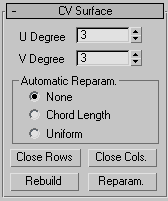CV surface sub-objects are similar to object-level CV surfaces.
To create a CV surface sub-object:
 (Create CV Surface).
(Create CV Surface).
The parameters that appear when you create a CV surface sub-object differ from those you see when you modify it as a sub-object.
Automatic Reparameterization group
The radio buttons in this group box let you choose automatic reparameterization. With reparameterization, the surface maintains its parameterization as you edit it. Without reparameterization, the surface's parameterization doesn't change as you edit it, and can become irregular.
Chooses the chord-length algorithm for reparameterization.
Chord-length reparameterization spaces knots (in parameter space) based on the square root of the length of each curve segment.
CV Surface rollout (modification time)

Let you set the degree of the surface in either the U or V dimension. The higher the degree value, the greater the continuity. The lower the degree, the more discontinuous the surface segments become. The degree can't be less than one or greater than the number allowed by the number of CVs in the specified dimension. Degree 3 is adequate to represent continuous surfaces, and is stable and well behaved. Default=3.
Setting the degree greater than 3 isn't recommended, because higher degrees are slower to calculate and less stable numerically. Higher degrees are supported primarily to be compatible with models created using other surface modeling programs.
The number of CVs in a given dimension must be at least one greater than that dimension's degree.
Automatic Reparameterization group
The radio buttons in this group box let you choose automatic reparameterization. With reparameterization, the surface maintains its parameterization as you edit it. Without reparameterization, the surface's parameterization doesn't change as you edit it, and can become irregular.
Chooses the chord-length algorithm for reparameterization.
Chord-length reparameterization spaces knots (in parameter space) based on the square root of the length of each curve segment.
A uniform knot vector has the advantage that the surface will change only locally when you edit it. With the other two forms of parameterization, moving any CV can change the entire surface.
The close controls let you close a surface. They appear on the Point Surface rollout while an independent point surface sub-object is selected. They have no effect if the surface is already closed in that direction.
Displays the Rebuild CV Surface dialog, which lets you specify how to rebuild the surface. Rebuilding the surface can change its appearance.
Displays the Reparameterize dialog. Reparameterizing a surface changes the surface's parameter space to provide a better relation between control point locations and the shape of the surface.